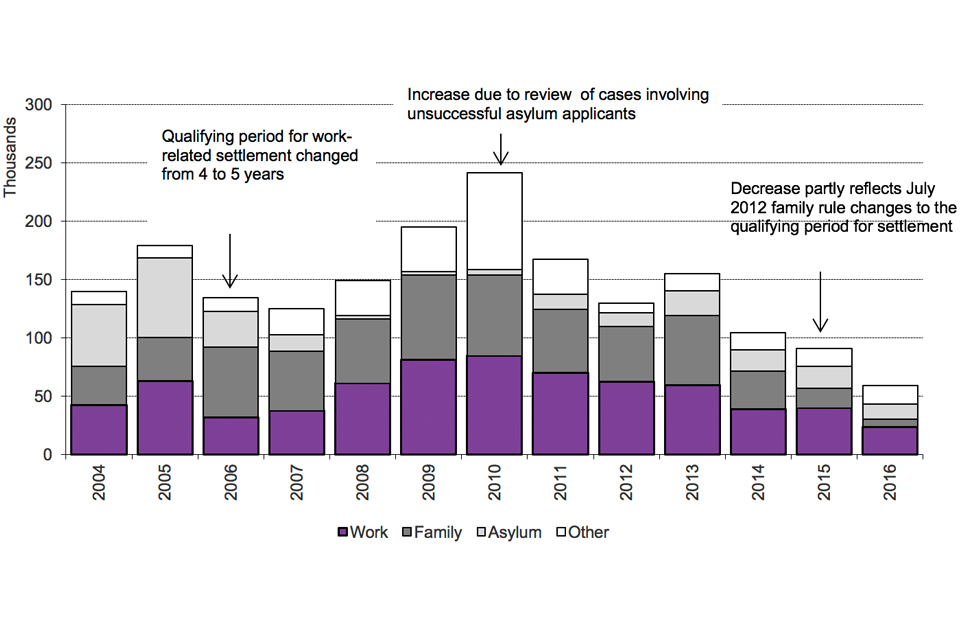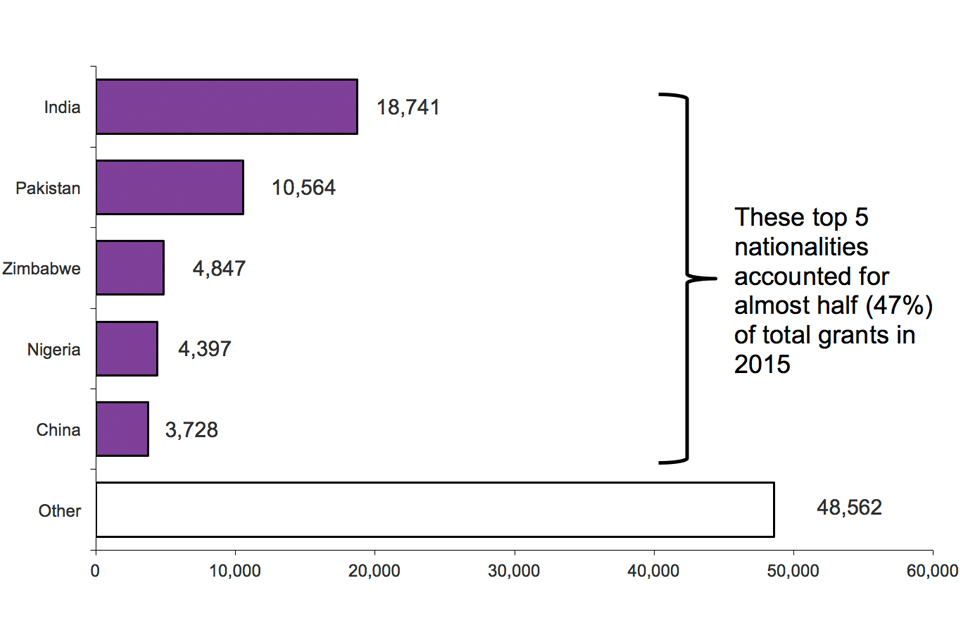Settlement
Published 23 February 2017
Valid: 23 February 2017 to 24 May 2017
Data relate to the calendar year 2016 and all comparisons are with the calendar year 2015, unless indicated otherwise.
Back to Immigration statistics October to December 2016 content page.
This is not the latest release. View latest release.
1. Key facts
There were 59,009 people granted permission to stay permanently in 2016, 35% or 31,830 fewer than the previous year. The decrease was largely accounted for by falls in work (-16,449), family (-10,160) and asylum-related (-5,824) grants. The number of grants is low relative to the peak number of grants in the year ending September 2010 (241,586), and similar to levels seen in 1997 (58,725).
Work-related grants to stay permanently fell by 41% to 23,342 (-16,449) in 2016. There were falls in grants to Tier 1 High-value individuals (by 8,162 to 10,656) and in the Tier 2 Skilled work category (by 7,089 to 9,345). This reflects fewer visa and extension grants 5 years earlier and a tightening of the rules (for further details see Policy and legislative changes affecting migration to the UK: timeline).
Family-related grants to stay permanently fell by 60% to 6,648 (-10,160) in 2016. There were notable decreases in grants to wives (by 5,646 to 3,727), husbands (by 3,186 to 1,535) and children (by 1,134 to 1,296). This may partly reflect changes to the rules in July 2012 on how quickly partners qualify for settlement and the number of visas and extensions granted in previous years. Details of the July 2012 rule changes are included in the Family section of the user guide.
Asylum-related grants to stay permanently fell by 31% to 13,071 in 2016, similar to the level seen in 2011 (13,003) and significantly lower than the peak in 2005 of 67,810.
Dependants of European Economic Area (EEA) and Swiss nationals in confirmed relationships may be shown separately in figures on issues and refusals of permanent residence documents, rather than in figures about settlement (further information is given in the [Family topic]). In 2016, 65,195 grants of documents certifying permanent residence and permanent residence cards were made. This is the highest recorded annual figure and more than 3 times (+47,131 or 261%) the figure for 2015.
These year-on-year comparisons of decisions numbers can be affected by changes in case-work resource allocation. Such fluctuations can be examined in more detail in the quarterly data that are also available in the published tables.
2. Grants to stay permanently by reason, and refusals
| Year | Total decisions | Total grants | Work | Asylum | Family | Other | Refusals |
|---|---|---|---|---|---|---|---|
| 2012 | 133,850 | 129,749 | 62,195 | 11,434 | 47,374 | 8,746 | 4,101 |
| 2013 | 161,375 | 154,701 | 59,288 | 21,274 | 59,654 | 14,485 | 6,674 |
| 2014 | 109,072 | 104,057 | 38,712 | 17,801 | 32,846 | 14,698 | 5,015 |
| 2015 | 95,922 | 90,839 | 39,791 | 18,895 | 16,808 | 15,345 | 5,083 |
| 2016 | 64,635 | 59,009 | 23,342 | 13,071 | 6,648 | 15,948 | 5,626 |
| Change: latest year | -31,287 | -31,830 | -16,449 | -5,824 | -10,160 | +603 | +543 |
| Percentage change | -33% | -35% | -41% | -31% | -60% | +4% | +11% |
2.1 Table notes
Source: Home Office, Immigration Statistics October to December 2016, Settlement table se 02 q.
3. Long-term trends in grants to stay permanently
The chart below illustrates longer-term trends in grants to stay permanently for the calendar years back to 2004.

The chart shows the number of people granted settlement by calendar year from 2004. The data are available in Table se 02.
3.1 Chart notes
Source: Home Office, Immigration Statistics October to December 2016, Settlement table se 02.
4. Nationalities granted permission to stay permanently
Data for grants by nationality in 2016 are planned to be published in Immigration Statistics April to June 2017, due to be released on 24 August 2017.
Of the total 90,839 grants of permission to stay permanently in 2015, over two-fifths (41% or 37,107) were to nationals of South Asia and nearly a quarter (23% or 20,927) were to nationals of Sub-Saharan Africa.
4.1 Top 5 nationalities granted permission to stay permanently, 2015
(Total number of grants: 90,839, includes dependants)

The chart shows grants of settlement by nationality in 2015. These top 5 nationalities accounted for almost half (47%) of total grants in 2015. The chart is based on data in Table se 03.
Chart notes
Source: Home Office, Immigration Statistics October to December 2016, Settlement table se 03.
5. Data tables
Further data on settlement are available in Settlement tables se 01 to se 06.
6. Background information
The figures in this section relate to the number of people, subject to immigration control, who are granted or refused permission to stay permanently in the UK, known as settlement.
From 2003 onwards, dependants of EEA and Swiss nationals in confirmed relationships may be shown separately in figures on issues and refusals of permanent residence documents, rather than in figures about settlement. Figures on issues and refusals of permanent residence documentation to EEA nationals and their family members are shown in EEA tables ee 02 and ee 02 q in the Family topic.
The numbers of applications and decisions about permission to stay permanently reflect changes over time in levels of those entering the country, as well as policy and legislative changes. These may affect the number of people potentially eligible to stay permanently. The availability and allocation of resources within the Home Office can also affect the number of decisions.
6.1 Migration transparency data webpage
A range of key input and impact indicators are currently published by the Home Office on the Migration transparency data webpage.
6.2 Staying in the UK
In February 2017, the Home Office published its ‘Statistics on changes in migrants’ visa and leave status: 2015’ formerly known as the ‘Migrant journey’ which shows how migrants subject to immigration control change their immigration status or achieve settlement in the UK.
